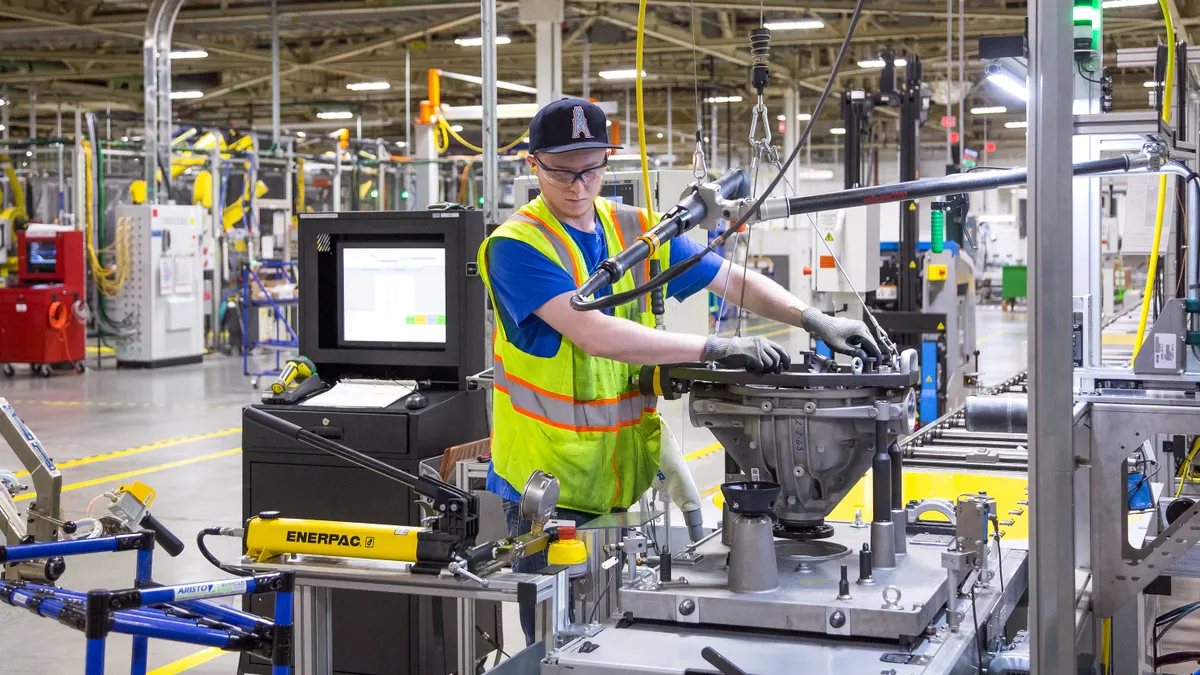Dive Brief:
- The U.S. manufacturing sector contracted for the fourth consecutive month in November, according to the Institute for Supply Management's (ISM) purchasing manager's index (PMI). A PMI of 50 or higher indicates growth in manufacturing, while a level below 50 indicates a contraction. The PMI came in at 48.1%, a 0.2 percentage point decrease from October's 48.3% reading, missing a target of 49.2% expected by a survey of Bloomberg economists.
- "Global trade remains the most significant cross-industry issue," Timothy Fiore, chair of the ISM Manufacturing Business Survey Committee, said in a statement. Food, beverage and tobacco products are strongest, while fabricated metal products are weakest, Fiore said.
- According to a report from the National Bureau of Statistics of China, China's PMI shows industry expansion, rising 0.9 percentage points from 49.3% in October to 50.2% in November, with its production index, new orders index and supplier distribution time index performing "higher than the threshold."
Dive Insight:
The U.S. PMI reached its lowest level of the year, and its lowest level since 2009, in September with a level of 47.8%. While it has recovered slightly since then, ongoing economic uncertainty and soft demand have kept industry from expanding.
According to ISM's report, the New Orders Index, a measure of demand, is contracting at a faster rate, registering 47.2%, a decrease of 1.9 percentage points October's 49.1%.

"Overall, inputs indicate (1) supply chains are meeting demand and (2) companies are less confident that materials received will be consumed in a reasonable time period," Fiore said. "Prices decreased for the sixth consecutive month, at a slower rate."
In addition to global trade challenges, namely the trade war with China, the General Motors strike may have also impacted the manufacturing sector. "The order book continues to shrink below our forecast levels. We’re unsure at this point how much of the slowdown is tied to certain events [like the General Motors strike], year-end inventory reductions by customers, or a worsening economy. We don't expect clarity on this until early 2020," according to a fabricated metals manufacturing firm quoted in ISM's survey,
As optimism around a Phase 1 trade deal between the U.S. and China falters, President Trump told reporters on Monday "it is better to wait until after the election" for a deal. Firms wanted a deal to be reached in time to avoid an impending round of tariffs set to launch on Dec. 15.
Despite uncertainty, China's manufacturing sector returned to expansion-level PMI readings in November, driven by increases in domestic manufacturing demand and enterprise expansion.
It is not out of the woods yet.
"It’s important to emphasize that considerable downward pressures remain on the economy," Chang Shu, chief Asia economist at Bloomberg, said in a research note. "And it’s unwise to read too much into a single month’s reading. Large jumps in activity are not unusual following China's week-long holidays, such as the Chinese New Year and in October. The trade talks with the U.S. will be a crucial swing factor for the outlook."















